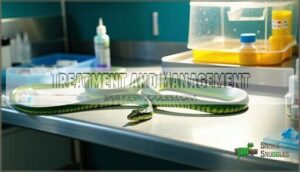This site is supported by our readers. We may earn a commission, at no cost to you, if you purchase through links.

Snake diseases how to treat requires professional veterinary diagnosis since symptoms like respiratory infections, mouth rot, or skin problems often share similar warning signs.
You can’t simply guess what’s wrong – bacterial infections need antibiotics, fungal issues require antifungal medications, and parasites demand specific anti-parasitic treatments.
Never attempt home remedies on serious conditions, as improper treatment can worsen your snake’s health.
Quick action and proper veterinary care make the difference between recovery and serious complications.
Understanding common symptoms helps you recognize when immediate professional intervention becomes necessary.
Table Of Contents
- Key Takeaways
- Snake Infections and Diseases
- Snake Fungal Diseases
- Nutritional Disorders in Snakes
- Eye and Ear Disorders in Snakes
- Bone and Muscle Disorders in Snakes
- Brain, Spinal Cord, and Nerve Disorders in Snakes
- Common Snake Health Issues
- Snake Wounds and Injuries
- Reproductive Disorders in Snakes
- Snake Health Maintenance and Prevention
- Frequently Asked Questions (FAQs)
- How do you treat a sick snake?
- How to get rid of snake fungal disease?
- How do you treat snake poisoning?
- How to get rid of snake parasites?
- How do you treat a snake infection?
- How do you treat snake fungal disease?
- What can I give my snake for a treat?
- How do you treat a reptile infection?
- What are the common snake diseases caused by adenoviruses?
- How do parasites affect the digestive tract of snakes?
- Conclusion
Key Takeaways
- You can’t diagnose snake diseases yourself – bacterial infections, fungal problems, and parasites require professional veterinary examination and specific treatments like antibiotics or antifungals.
- You’ll recognize common symptoms early – watch for respiratory signs, mouth rot, skin lesions, appetite loss, and behavioral changes that signal serious health issues requiring immediate attention.
- You must maintain proper habitat conditions – correct temperature gradients, humidity levels, and sanitation prevent most snake diseases from developing in the first place.
- You should establish quarantine protocols – isolate new snakes for 30-90 days and use dedicated equipment for each animal to prevent disease transmission between your pets.
Snake Infections and Diseases
When your snake develops an infection or disease, recognizing the warning signs early can mean the difference between a quick recovery and a serious health crisis.
Most snake infections stem from poor husbandry conditions, stress, or contact with infected animals, but proper treatment can restore your pet’s health when caught in time, which is crucial for a quick recovery.
Early detection and proper care can save your snake‘s life when infections strike.
Adenovirus and Infectious Stomatitis
When dealing with adenovirus transmission and infectious stomatitis, you’re facing serious snake viral disease and snake bacterial infection challenges.
Stomatitis symptoms include oral hemorrhage, thick mucus, and mouth rot development. Secondary infections complicate treatment, requiring systemic antibiotics and supportive care.
Treatment efficacy depends on early intervention and proper environmental management. A key concern is inclusion body disease, primarily affecting boas and pythons.
Preventative measures include strict quarantine protocols and regular disinfection to prevent snake mouth rot outbreaks.
Parasites and Roundworms
While infectious stomatitis affects the mouth, parasites and roundworms target your snake’s digestive system.
These internal invaders can seriously compromise your pet’s health if left untreated.
- Roundworm lifecycle involves eggs passed through feces that contaminate the environment
- Parasite diagnosis requires regular fecal exams every 6-12 months for early detection
- Ivermectin treatment and other snake antiparasitic drugs effectively target snake helminths
- Preventative measures include quarantine protocols and immediate fecal removal from enclosures
Snake parasites pose zoonotic potential, making proper hygiene essential during cleaning.
Deworming protocols typically involve multiple treatments with snake parasite treatment medications under veterinary supervision.
Regular faecal tests are essential for early detection.
Symptoms and Diagnosis
Recognizing snake disease symptoms early can save your pet’s life.
Watch for behavioral changes like lethargy, hiding, or unusual aggression. Appetite loss often signals underlying health issues.
Check for skin abnormalities including lesions, swelling, or abnormal shedding patterns.
Respiratory signs like mouth breathing, wheezing, or nasal discharge indicate serious problems.
Diagnostic methods include physical exams, blood work, and fecal testing to confirm specific conditions and guide treatment decisions.
Treatment Options and Prevention
Once you’ve spotted the warning signs, swift action can save your snake’s life. Antibiotic usage targets bacterial infections, while antifungal medications combat fungal problems. Wound management and probiotic therapy support recovery. Quarantine protocols prevent disease spread to other reptiles.
Many owners find snake antibiotic products useful in treatment.
- Snake antibiotics require veterinary prescription and precise dosing schedules
- Snake antifungal medication treats scale rot and respiratory fungal infections effectively
- Snake vet care includes regular health screenings and emergency intervention protocols
- Snake disease prevention focuses on proper humidity, temperature control, and habitat sanitation
Snake Fungal Diseases
Snake fungal disease (SFD) presents a serious threat to your pet’s health, causing crusty skin lesions, facial swelling, and potentially fatal complications if left untreated.
You’ll need prompt veterinary care and a combination of antifungal treatments to save your snake from this aggressive infection.
Causes and Risk Factors
Understanding what triggers snake fungal diseases helps you protect your scaly companion.
Several snake disease risk factors create the perfect breeding ground for these infections. Poor Hygiene tops the list – dirty enclosures with accumulated waste provide ideal conditions for fungal growth. Stress Factors weaken your snake’s natural defenses, making them vulnerable to infection. Environmental Issues like improper humidity levels create moisture problems that fungi love.
Key contributors include:
- Genetic Predisposition – some species are naturally more susceptible
- Weakened Immunity from snake poor nutrition or illness
- Snake overcrowding in inadequate housing conditions
Your snake environment and snake hygiene practices directly impact disease risk. Maintaining proper conditions prevents most fungal problems before they start.
Symptoms and Stages
Before symptoms appear, snake fungal disease has already taken hold of your pet’s system.
Early symptoms include facial swelling, discolored skin patches, and crusty lesions that make your snake look uncomfortable. As disease progression continues, you’ll notice abnormal molting patterns and increased basking behavior.
Symptom variability depends on your snake’s species and immune status. Diagnostic indicators become more obvious as severity stages advance – blisters form, eyes cloud over, and skin thickens dramatically.
Advanced cases show ulcerated tissue, internal organ involvement, and significant weight loss that threatens survival.
Early Signs Disease Progression Treatment Stages
Diagnosis and Testing
Once you’ve identified troubling symptoms, accurate diagnosis becomes your priority.
Your veterinarian will conduct Physical Exams and collect samples for Fecal Analysis to check for parasites.
Blood Work reveals systemic infections, while PCR Testing detects specific fungal DNA.
Culture Methods grow organisms from skin samples, confirming snake diseases.
These snake blood tests and snake bacterial culture results guide treatment decisions.
Multiple diagnostic approaches guarantee accurate snake disease diagnosis, helping your vet create an effective treatment plan.
Treatment and Management
Treatment combines targeted antibiotic therapy and supportive care to combat fungal infections effectively.
Your veterinarian will prescribe specific antifungal medications while surgical options may address severe lesions.
Environmental control maintains proper temperature and humidity for recovery.
Snake veterinary care includes wound management and nutritional support throughout treatment.
Some owners find snake antibiotic products helpful.
Snake health management focuses on preventative measures like habitat hygiene to prevent reinfection and guarantee the best healing outcomes.
Nutritional Disorders in Snakes
Your snake’s nutritional health depends on proper feeding practices and adequate vitamin and mineral intake.
Poor nutrition can lead to serious conditions like metabolic bone disease, organ dysfunction, and weakened immune systems that make your pet vulnerable to other illnesses.
Secondary Nutritional Hyperparathyroidism
After tackling fungal infections, calcium deficiency poses another serious threat to your snake’s health.
Secondary Nutritional Hyperparathyroidism develops when poor snake nutrition creates a dietary imbalance, leading to metabolic bone disease. This condition weakens your snake’s skeletal system, causing dangerous complications.
- Calcium Deficiency results from inadequate dietary calcium or improper calcium-to-phosphorus ratios
- UV Lighting deficiency prevents vitamin D3 synthesis, reducing calcium absorption in your snake’s body
- Snake Husbandry improvements including proper diet and lighting prevent this devastating snake health condition
Secondary Renal Hyperparathyroidism
Secondary Renal Hyperparathyroidism strikes when chronic kidney disease disrupts your snake’s calcium-phosphorus balance.
This renal disease creates a cascade effect where damaged kidneys can’t properly excrete phosphorus, leading to elevated phosphorus levels and calcium imbalance.
Your snake’s body responds by pulling calcium from bones, causing metabolic bone disease.
Poor snake nutrition and inadequate vitamin D metabolism worsen this condition.
Proper dietary management and veterinary care are essential for managing these serious snake health problems.
Causes Effects
Vitamin and Mineral Deficiencies
Maintaining proper nutrition prevents serious snake health problems that can devastate your pet’s well-being.
Vitamin A Deficiency causes respiratory infections and eye issues, while Calcium Deficiency leads to bone deformities and muscle weakness.
Thiamine Deficiency triggers neurological symptoms like seizures.
Without adequate Vitamin D3, calcium absorption fails completely.
Mineral Imbalances create cascading health issues requiring immediate veterinary care.
Proper supplementation and whole-prey feeding prevent malnutrition and costly snake disease treatment down the road.
Feeding and Nutrition Tips
Proper nutrition prevents many health issues that plague pet snakes. Prey size should match your snake’s thickest body section, while feeding frequency depends on age and species.
Always provide fresh water through appropriate hydration methods. Avoid excessive supplementation needs unless veterinary-recommended. Food preparation matters—thaw frozen prey completely before offering.
- Match prey width to snake’s girth for proper digestion
- Feed juveniles weekly, adults every 2-4 weeks typically
- Replace water regularly to prevent bacterial growth
- Only supplement when deficiencies are confirmed by testing
- Thaw prey safely to room temperature before feeding
Eye and Ear Disorders in Snakes
Your snake’s eyes and ears might seem simple, but they’re actually vulnerable spots where infections can quickly develop into serious health problems.
Eye infections often start as minor irritations but can progress to painful abscesses, while ear canal impactions can affect your snake’s balance and overall well-being, leading to issues with its balance.
Eye Infections and Abscesses
Your snake’s eyes can develop several serious conditions that need quick attention. Corneal Ulcers appear as cloudy spots, while Spectacle Problems cause stuck eye caps.
Subspectacular Abscess creates painful swelling beneath the eye covering. Eye Trauma from rough handling or sharp objects requires immediate veterinary care.
Cataracts cloud vision permanently. Watch for discharge, swelling, or behavioral changes.
Retained eye caps can also lead to discomfort and vision impairment if not addressed promptly.
Snake bacterial infection around eyes needs antibiotics and proper snake wound care to prevent complications affecting snake health.
Ear Infections and Impactions
Occasionally, snakes develop ear infections and impactions that require immediate attention to prevent hearing loss and systemic complications.
Understanding ear anatomy helps you recognize when infection types like bacterial pathogens compromise your snake’s health.
Key signs to watch for:
- Swelling or bulging at the ear membrane indicating abscess formation
- Thick discharge visible through the ear membrane in advanced cases
- Head rubbing and behavioral changes suggesting discomfort
- Decreased appetite and lethargy from pain or infection
- Abnormal neurological symptoms indicating deeper ear involvement
Treatment options include surgical drainage for severe infections, followed by antibiotics to eliminate bacterial infection.
Impaction causes often stem from accumulated shed skin or debris, requiring manual removal under veterinary care.
Early intervention prevents progression to permanent hearing loss and systemic snake diseases.
Bone and Muscle Disorders in Snakes
Your snake’s skeleton and muscles face unique challenges that can seriously impact their health and movement.
These disorders often stem from poor nutrition, inadequate lighting, or improper housing conditions that weaken bones and cause muscle deterioration over time, leading to issues such as muscle deterioration.
Abnormal Beak Growth and Secondary Nutritional Hyperparathyroidism
Several reptile species suffer from metabolic bone disease, with secondary nutritional hyperparathyroidism being particularly devastating for snake health. This condition develops when dietary imbalance creates calcium deficiency, causing your snake’s body to leach calcium from bones to maintain blood levels.
The result? Soft, rubbery bones that fracture easily. Beak overgrowth often signals underlying nutritional problems. Without proper UV lighting and balanced nutrition, your snake can’t absorb calcium effectively, leading to:
- Weakened jaw bones that bend under normal use
- Difficulty eating due to misaligned teeth
- Pathological fractures from minor stress
- Progressive skeletal deformities over time
- Increased susceptibility to other health complications
Husbandry impact extends beyond just feeding schedules. Veterinary care becomes essential when you notice soft jaw tissues or eating difficulties. Early intervention prevents the need for snake force feeding or intensive snake fluid therapy later, which can help prevent progressive skeletal deformities and reduce the risk of other health complications.
Muscle Weakness and Atrophy
Beyond simple weakness, muscle atrophy in snakes represents a serious deterioration that affects their quality of life.
When your snake’s muscles waste away, you’ll notice reduced mobility and compromised hunting abilities.
| Causes | Diagnosis | Treatment |
|---|---|---|
| Poor nutrition lacking protein | Physical examination reveals muscle mass loss | Dietary corrections with high-quality prey |
| Inadequate exercise opportunities | Blood tests show protein deficiencies | Supervised exercise programs |
| Chronic snake diseases | Muscle biopsy confirms atrophy | Veterinary rehabilitation protocols |
| Prolonged snake lethargy | Behavioral assessment indicates weakness | Environmental enrichment strategies |
Prevention involves providing balanced nutrition and adequate space for movement.
Treatment focuses on addressing underlying causes of snake loss of appetite while implementing structured rehabilitation.
Early intervention prevents permanent muscle damage and restores your snake’s strength effectively.
Bone Fractures and Osteoporosis
Beyond simple breaks, bone fractures and osteoporosis represent serious snake health challenges requiring immediate attention.
Fracture types vary from hairline cracks to complete breaks, often stemming from calcium deficiency and metabolic bone disease.
Poor bone density makes your snake vulnerable to injuries during handling or movement.
Snake X-rays help veterinarians assess damage severity and monitor the healing process.
Proper reptile care includes calcium-rich diets and UVB lighting to prevent metabolic bone disorders that weaken skeletal structures over time, which can be caused by metabolic bone disease.
Treatment and Prevention
Your snake’s bone health depends on proactive care and early intervention.
Proper treatment prevents devastating complications that can affect your pet’s quality of life.
- Provide calcium-rich prey and supplement with vitamin D3 to strengthen bones
- Maintain ideal temperatures (75-85°F) for proper calcium absorption and metabolism
- Implement strict quarantine procedures for new snakes to prevent disease transmission
- Use preventative medications as recommended by your veterinarian for at-risk animals
- Create environmental enrichment with appropriate substrates to reduce injury risks
Early detection through regular veterinary check-ups helps identify bone disorders before they become severe.
Antibiotic resistance concerns make prevention vital for long-term snake health.
Brain, Spinal Cord, and Nerve Disorders in Snakes
Neurological disorders in snakes can seriously affect their ability to move, eat, and survive in captivity.
You’ll need to recognize symptoms like abnormal head positioning, seizures, and coordination problems to get your snake proper veterinary care before these conditions become life-threatening, which requires understanding and identifying symptoms.
Stargazing and Nervous System Disorders
When your snake exhibits stargazing behavior, neurological symptoms signal serious underlying conditions requiring immediate veterinary attention.
This involuntary head extension indicates central nervous system dysfunction with potentially fatal consequences.
| Condition | Primary Symptoms | Prognosis |
|---|---|---|
| Inclusion Body Disease | Stargazing effects, tremors, regurgitation | Poor/fatal |
| Viral infections | Disorientation, muscle spasms, appetite loss | Variable |
| Trauma/toxins | Head tilting, loss of righting reflex | Depends on cause |
IBD correlation remains strongest in boas and pythons, with no effective treatment research available.
Viral impact on snake health creates progressive neurological deterioration.
Early snake disease management focuses on supportive care while addressing underlying causes.
Bacterial infections respond to antibiotics, but viral-induced stargazing typically proves irreversible, making prevention through proper biosecurity essential for snake diseases.
Bacterial Meningitis and Encephalitis
Bacterial meningitis and encephalitis represent serious neurological complications that develop when bacterial infections spread through your snake’s bloodstream to brain and spinal cord tissue.
These conditions require immediate veterinary attention since they can quickly become fatal without proper treatment.
Causes include untreated septicemia and systemic bacterial infections that cross the blood-brain barrier.
Diagnosis involves clinical examination, blood work, and sometimes cerebrospinal fluid analysis to identify the specific bacterial pathogen.
Treatment requires aggressive antibiotic therapy, supportive care, and hospitalization for monitoring neurological function.
Prevention focuses on maintaining proper husbandry and treating bacterial infections before they become systemic.
Common Snake Health Issues
As a snake owner, you’ll encounter several common health issues that require prompt attention and proper treatment.
These problems range from appetite loss and bacterial infections to skin conditions and unusual swellings that can seriously impact your pet’s wellbeing.
Anorexia and Loss of Appetite
While neurological disorders affect snake behavior, appetite problems stem from different causes.
When your snake stops eating, multiple factors could be at play.
Environmental stress, improper temperatures, or underlying infections commonly trigger this response.
| Causes | Diagnosis | Treatment |
|---|---|---|
| Temperature fluctuations | Physical examination | Environmental correction |
| Stress factors | Behavioral assessment | Appetite stimulants |
| Infections | Blood work | Force-feeding if needed |
| Seasonal changes | Fecal testing | Veterinary intervention |
Snake diseases often manifest through loss of appetite first.
Quick diagnosis prevents complications.
Treatment involves addressing root causes while maintaining proper snake care protocols during recovery.
Salmonella and Bacterial Infections
While appetite issues are concerning, bacterial infections pose even greater risks to your snake’s health.
Salmonella and other bacterial pathogens create serious threats through septicemia and antibiotic resistance.
Understanding these snake bacterial infections helps you protect both your pet and family from zoonotic risks.
- Salmonella transmission occurs through direct contact with infected snakes or contaminated surfaces
- Carrier states mean healthy-appearing snakes can still shed dangerous bacteria in their feces
- Infection prevention requires strict hygiene protocols and proper enclosure maintenance
- Snake diseases from bacteria demand immediate veterinary attention and targeted antibiotics treatment
Abnormal Swellings and Masses
When you spot unusual lumps or swellings on your snake, don’t panic—these growths need proper veterinary evaluation to determine their nature and appropriate treatment approach.
Abscess Identification involves recognizing inflamed, pus-filled pockets that feel warm and soft. Tumor Types range from benign lipomas to malignant growths requiring immediate attention. Cyst Formation creates fluid-filled sacs under the skin, while Granuloma Causes include foreign body reactions or chronic inflammation. Hematoma Diagnosis reveals blood-filled swellings from trauma.
Skin lumps can also indicate parasites like mites, which require careful monitoring and treatment.
Here’s your action plan for snake diseases involving abnormal masses:
- Schedule immediate veterinary examination for accurate diagnosis and treatment planning
- Document growth characteristics including size, location, texture, and any changes over time
- Prepare for potential procedures such as needle aspiration, biopsy, or surgical removal
- Follow antibiotic protocols if bacterial infection contributes to swelling formation
Early intervention prevents complications and guarantees the best snake health outcomes.
Difficulty Shedding and Skin Problems
Dysecdysis happens when your snake can’t shed properly, leaving retained skin patches that create problems.
Poor humidity, mite infestations, or underlying skin infections like scale rot and blister disease are common dysecdysis causes.
Check your shedding environment – it needs 70-80% humidity.
Remove stuck shed gently with warm water soaks to prevent snake skin conditions from worsening.
Snake Wounds and Injuries
Physical injuries in snakes can range from minor cuts to severe burns, requiring immediate attention to prevent infection and promote healing.
Minor cuts to devastating burns – every snake injury demands swift action to prevent deadly infections and ensure complete recovery.
You’ll need to recognize different types of wounds and understand proper first aid techniques to keep your snake healthy and comfortable during recovery, which involves providing the right environment for healing.
Burns and Thermal Injuries
Thermal burns from heat sources require immediate action.
Move your snake away from the heat source and assess burn severity.
Cool areas show minor damage, while blisters indicate deeper injury.
Seek veterinary care for proper wound cleaning and pain control.
Monitor for skin infections and dermatitis during healing.
Prevent scarring by maintaining proper humidity levels and avoiding further trauma to damaged scales.
Bites and Wounds From Other Animals
When other animals attack your snake, Infection Risks escalate quickly.
Clean wounds immediately with antibacterial soap and apply first aid basics.
Monitor for swelling, discharge, or redness indicating septicemia.
Contact your vet for medical treatment and Antibiotic Use guidance.
Proper Wound Cleaning and Pain Management prevent complications while supporting Scarring Prevention during healing.
Injuries From Handling and Restraint
While restraining your snake, improper grip pressure can cause Constriction Injuries and Scale Damage.
Excessive force during snake handling leads to Spinal Trauma and Muscle Strain.
Your snake’s natural Stress Response makes injuries worse.
Support the body properly, never grab just the head or tail, and move slowly to prevent these common handling mishaps that require immediate medical treatment.
Treatment and First Aid
When injuries occur, quick action saves lives.
Clean minor wounds with sterile saline, then apply topical antibiotic therapy.
Severe injuries require immediate veterinary care and possible hospitalization.
Your vet will provide pain management, fluid therapy, and injectable antibiotics if needed.
Supportive care during recovery includes proper wound care and monitoring.
Specialized products can aid in snake wound healing.
Stay calm—prompt treatment prevents complications and guarantees your snake’s recovery.
Reproductive Disorders in Snakes
Reproductive disorders can seriously impact your snake’s health and breeding success, requiring prompt recognition and treatment.
Common issues include dystocia (difficulty laying eggs), egg binding, and various fertility problems that need veterinary intervention to prevent life-threatening complications.
Dystocia and Egg Binding
Beyond wounds and injuries, reproductive complications can threaten your snake’s health. Dystocia and egg binding occur when females can’t expel eggs naturally. You’ll notice straining, lethargy, and abdominal swelling.
Causes of Dystocia include improper husbandry and malformed eggs. Diagnosing Egg Binding requires X-rays and physical examination. Treating Dystocia involves supportive care, hormones, or surgery.
Preventing Egg Binding means proper nutrition and nesting sites. Post-Dystocia Care includes monitoring for infection and future reproductive issues.
- Watch for straining behaviors and swollen abdomen indicating egg retention
- Seek immediate veterinary care for proper diagnosis and treatment options
- Maintain ideal temperature, humidity, and calcium supplementation for prevention
Infertility and Breeding Issues
Breeding snakes can be tricky when infertility strikes. Poor reproductive health affects both males and females, making successful breeding challenging.
Understanding common fertility issues helps you identify problems early and take corrective action.
- Egg Development: Poor nutrition or environmental stress can cause weak, malformed, or infertile eggs that won’t hatch successfully
- Sperm Quality: Male snakes may produce poor-quality sperm due to age, stress, or inadequate nutrition affecting fertilization rates
- Reproductive Anatomy: Physical abnormalities in reproductive organs can prevent successful mating or egg development in breeding pairs
- Hormonal Imbalance: Incorrect temperature cycles or lighting can disrupt natural breeding hormones essential for reproduction
- Breeding Management: Proper quarantine, health screening, and environmental control are essential for snake diseases treatment and prevention
Snake Health Maintenance and Prevention
You can’t prevent every snake disease, but consistent care makes all the difference between a healthy pet and costly vet bills.
Creating the right environment, maintaining proper nutrition, and following basic biosecurity measures will keep most common health problems at bay, which is crucial for a healthy pet and can be achieved through proper care.
Regular Veterinary Check-Ups
Why wait until problems arise when preventative care can save your snake’s life?
Regular veterinary check-ups provide early detection of snake diseases before they become serious. Schedule annual exams with a reptile-experienced veterinarian for thorough health monitoring and expert advice on treatment planning.
Here’s your veterinary care schedule:
Snake Age Check-up Frequency
Regular vet checkups guarantee superior snake health through professional prevention strategies.
Early detection of issues like infectious stomatitis symptoms can improve treatment outcomes.
Proper Housing and Environmental Conditions
Creating a proper home environment acts as your snake’s first line of defense against snake diseases.
Temperature gradients should range from a warm basking spot to a cooler retreat area, while humidity levels must match your species’ specific needs. Poor environmental conditions—especially improper environmental temperature and improper environmental humidity—can weaken your snake’s immune system and trigger health problems.
- Temperature gradients: Provide a warm side (85-95°F) and cool side (75-80°F) with accurate thermostats
- Humidity levels: Maintain 50-60% for most species, using hygrometers for monitoring
- Enclosure size: Offer space equal to your snake’s length for adequate movement
- Substrate choices: Choose safe materials like aspen shavings or cypress mulch that won’t cause impaction
- Sanitation protocols: Clean water bowls weekly, spot-clean waste immediately, and deep-clean monthly to prevent bacterial growth
Nutrition and Feeding Guidelines
A balanced diet prevents malnutrition and snake diseases in pet snakes.
Choose appropriate prey size – typically 10-15% of your snake’s body weight. Feeding frequency varies by species: juveniles need weekly meals, adults every 2-3 weeks.
Avoid overfeeding to prevent obesity, which weakens immunity. Supplementation needs are minimal with whole prey diets.
Fresh water maintains hydration importance – change it weekly or when contaminated.
Monitor your snake’s body condition regularly. Signs of dehydration include sunken eyes and sticky mouth.
Proper diet supports immune function, reducing disease susceptibility and promoting longevity.
Biosecurity and Disease Prevention Measures
Your snake’s health depends on smart biosecurity practices that act like a protective shield.
Quarantine protocols require isolating new animals for 30 days minimum. Proper hygiene practices include disinfecting enclosures with bleach solutions and using dedicated equipment for each snake.
Deep cleaning prevents pathogen buildup, while vector control eliminates disease carriers.
- Quarantine new snakes for 30-90 days using paper substrate
- Sanitize equipment with 0.15% bleach solution after each use
- Monitor health through regular visual inspections and weight checks
- Maintain separation using different rooms for quarantined animals
Frequently Asked Questions (FAQs)
How do you treat a sick snake?
Time is of the essence when your serpent companion falls ill.
You’ll need to identify symptoms quickly, then consult an exotic veterinarian for proper diagnosis and treatment plans customized to your snake’s specific condition.
How to get rid of snake fungal disease?
You’ll need veterinary care for proper diagnosis and treatment. Antifungal medications, both topical and systemic, are essential. Surgical removal of infected tissue may be required for severe cases.
How do you treat snake poisoning?
Don’t panic thinking you’ll lose your beloved pet immediately. You’ll need to rush to an exotic veterinarian for emergency treatment, supportive care, and antivenom if available for your snake’s survival.
How to get rid of snake parasites?
You’ll need veterinary-prescribed medications like ivermectin or metronidazole for internal parasites, plus environmental deep cleaning. External parasites require specialized treatments and complete habitat sterilization to prevent reinfection.
How do you treat a snake infection?
Bacterial infections affect 70% of captive snakes at some point.
You’ll need veterinary-prescribed antibiotics, proper wound cleaning, and environmental improvements.
Clean the enclosure, maintain correct temperature and humidity levels, and provide supportive care.
How do you treat snake fungal disease?
You’ll treat snake fungal disease using systemic and topical antifungals prescribed by a veterinarian. Surgical removal of lesions may be necessary alongside thermal, fluid, and nutritional support for recovery.
What can I give my snake for a treat?
Studies show 95% of snakes thrive on species-appropriate prey alone.
You can offer frozen-thawed mice, rats, or chicks sized appropriately for your snake’s girth.
Avoid processed foods or treats designed for other pets, as these can cause digestive issues.
How do you treat a reptile infection?
You’ll need to identify the specific infection type first, then consult an exotic veterinarian immediately.
Treatment typically involves antibiotics for bacterial infections, antifungals for fungal issues, and supportive care including proper temperature, hydration, and wound cleaning.
What are the common snake diseases caused by adenoviruses?
Looking for trouble with adenoviruses? You’re facing a complex diagnostic challenge, as adenoviruses in snakes aren’t well-documented like bacterial infections.
These viruses typically cause immunosuppression, making your snake vulnerable to secondary infections and complicating treatment protocols substantially.
How do parasites affect the digestive tract of snakes?
Parasites wreak havoc on your snake’s digestive system by attacking intestinal cells, causing poor nutrient absorption, diarrhea, regurgitation, and significant weight loss that weakens your pet’s overall health.
Conclusion
Successfully treating snake diseases requires vigilant observation and professional veterinary care.
Consider Sarah’s ball python, who developed respiratory symptoms that initially seemed minor but progressed to severe breathing difficulties within days.
Her quick veterinary consultation revealed a bacterial infection requiring specific antibiotic treatment.
Understanding snake diseases means recognizing that early intervention prevents complications, and you’ll save your snake’s life by acting promptly when symptoms appear.
Following prescribed treatments precisely, and maintaining ideal habitat conditions to prevent future illness occurrences, are crucial steps in ensuring the health and well-being of your snake.
- https://www.merckvetmanual.com/all-other-pets/reptiles/disorders-and-diseases-of-reptiles
- https://www.frontiersin.org/journals/veterinary-science/articles/10.3389/fvets.2021.733404/full
- https://pmc.ncbi.nlm.nih.gov/articles/PMC4254391/
- https://www.thebhs.org/publications/the-herpetological-bulletin/issue-number-8-winter-1983/2155-hb008-05/file
- https://www.fws.gov/question-answer/understanding-snake-fungal-disease-impacts-treatments-and-prevention





















